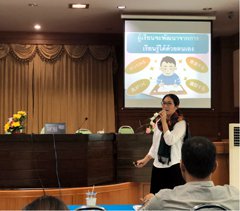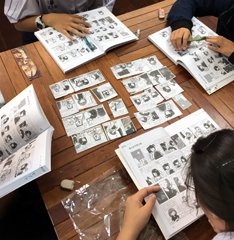A Desire to Convey My “Image of Teachers”
The Japan Foundation, Bangkok (Northeast Thailand)
HACHISUKA Makiko
“Nakhon Ratchasima”
This incantation-sounding phrase is the name of the largest province in Thailand, and the gateway to the northeast region. It is about four hours from Bangkok by coach. In this town, the main missions driving the activities of the Japanese-Language Specialists (hereinafter “Specialists”) in charge of secondary education in Northeast Thailand are “supporting secondary education for the entire northeast region” and “supporting the schools to which are dispatched.”
1. Supporting Secondary Education for the Entire Northeast Region
There are 20 provinces in Northeast Thailand, and almost all the provinces have several secondary educational institutions carrying out Japanese-language education. Japanese is a popular subject as a second foreign language, and many schools have even established Japanese as a major course. Specialists visit these schools, and while there, they exchange information with the teachers and get the teachers to tell them about the school, the learning environment and the circumstances surrounding the Japanese-language subject at the school. In some cases, they also meet with the head of the foreign languages department or the principal. Within that, one of their major roles is to observe Japanese-language classes and provide the teachers with feedback. Many schools warmly welcome the visits by Specialists, with the teachers listening attentively to the Specialists’ advice on their classes and activities.

“Marugoto: Japanese Language and Culture” seminar “Ensure the concept is conveyed…”
Based on what I heard over the past year alone, there are more than 150 institutions providing Japanese-language education in the northeast region. That number means it is simply not possible to visit one school multiple times. Furthermore, in some cases the schools take at least two hours to reach by shared van, and visiting regions adjoining the border with Laos can take more than seven hours by coach. Nevertheless, during my term, I want to visit as many schools and talk to as many teachers as possible! That is because unlike in Bangkok and other famous cities, there are not many Japanese nationals living in the northeast. Only a handful of schools employ teachers who are native Japanese speakers. The “living Japanese people” who visit under the “NIHONGO Partners” program are very much welcomed. Furthermore, in small country towns and villages, most of the students have never seen a Japanese person. The teachers at these schools have no day-to-day contact with Japanese people, but they strive singlehandedly to encourage their students to take a greater interest in Japan and the Japanese language. I hope to draw close to these teachers and built relationships with them where they are able to ask anything comfortably.
Even in Thailand, in recent years the Ministry of Education has come out with a new policy of cultivating 21st Century skills and recommending “Active Learning.” The students who completed the final fiscal year of the “New Training Course for In-service Japanese-Language Teachers in Secondary Schools” (hereinafter “OBEC Training”), which was held from 2013 to 2017, took up posts one after the other in fiscal 2018 to begin their teaching careers. Now, they are literally trying to transform the front lines of Japanese-language education. And a major mission of Specialists is also to support that change. At the fiscal 2018 “Japanese-Language Education Training in Northeast Thailand,” I held seminars in two locations in the northeast to introduce the concepts underlying the “Marugoto: Japanese Language and Culture” (hereinafter “Marugoto”) teaching material developed by The Japan Foundation. At secondary educational institutions in Thailand, “Akiko To Tomodachi,” which was developed by The Japan Foundation, Bangkok, is being used as the main teaching material at many schools. However, I feel that few teachers are making sufficient use of the “take notice and think for yourself” concept. This is a concept that “Marugoto” also shares. I began the seminars with the desire to convey the idea that “cultivating learners who study on their own strengths” will be a major role of teachers from here on.
Going forward also, I intend to hold training throughout the northeast using “Marugoto” as the teaching material, and to convey an “image of teachers” for the new era.
2. Supporting the Schools to which They Are Dispatched
Another mission is supporting Japanese-language education at the school to which I am dispatched. The school I am dispatched to is Suranaree Wittaya School, a famous and well-established combined lower and upper secondary school for girls in the northeast. In fiscal 2018, a student who had finished the above-mentioned OBEC Training took up a post as a newly-appointed teacher at the school. Specialists cooperate with three other teachers, centering on this Thai teacher, to consider class and activity ideas together, and to provide class support. I hope that by thinking and working together it will be possible to convey my “image of teachers” to them.

Classes full of ideas that students do not get bored of
I believe that my work at Suranaree Wittaya School allows me to have the perspective of a “front-line teacher” while simultaneously having the perspective of Japanese-Language Chief Advisor, and this is also a significant aspect of the work. That is because Specialists themselves exist not only as native Japanese-language speakers (native Japanese), but are also able to gain a sense of Thai teachers’ way of thinking and way of working, and the learning styles, trends and so on of students. Without this perspective as a “front-line teacher,” it would undoubtedly be difficult to plan training that would capture the interest of teachers and make them think: “I’ll try introducing that to the class.” Even after I have been away from Suranaree Wittaya School for work for several days, the school and my colleagues welcome me back warmly. For me, both are a significant presence.
The new school term starts in May, after Songkran (Thailand’s New Year). What sorts of new students will enter this year, and what sorts of classes will make their eyes sparkle?
This year also, I am looking forward to travelling around the 20 provinces meeting new people and making new discoveries, to further enrich and develop Japanese-language education in Northeast Thailand.
- What We Do Top
- Arts and Cultural Exchange [Culture]
- Japanese-Language Education Overseas [Language]
- Japanese-Language Education Overseas [Language] Top
- Learn Japanese-language
- Teach Japanese-language
- Take Japanese-Language Test
- Know about Japanese-language education abroad
- The Japanese-Language Institute, Urawa
- The Japanese-Language Institute, Kansai
- Japanese-Language Programs for Foreign Specified Skilled Worker Candidates
- Japanese Language Education for Japanese Children Resident Overseas and for the Descendants of Migrants
- Archives
- Japanese Studies and Global Partnerships [Dialogue]
- JF digital collection
- Other Programs / Programs to Commemorate Exchange Year
- Awards and Prizes
- Publications
